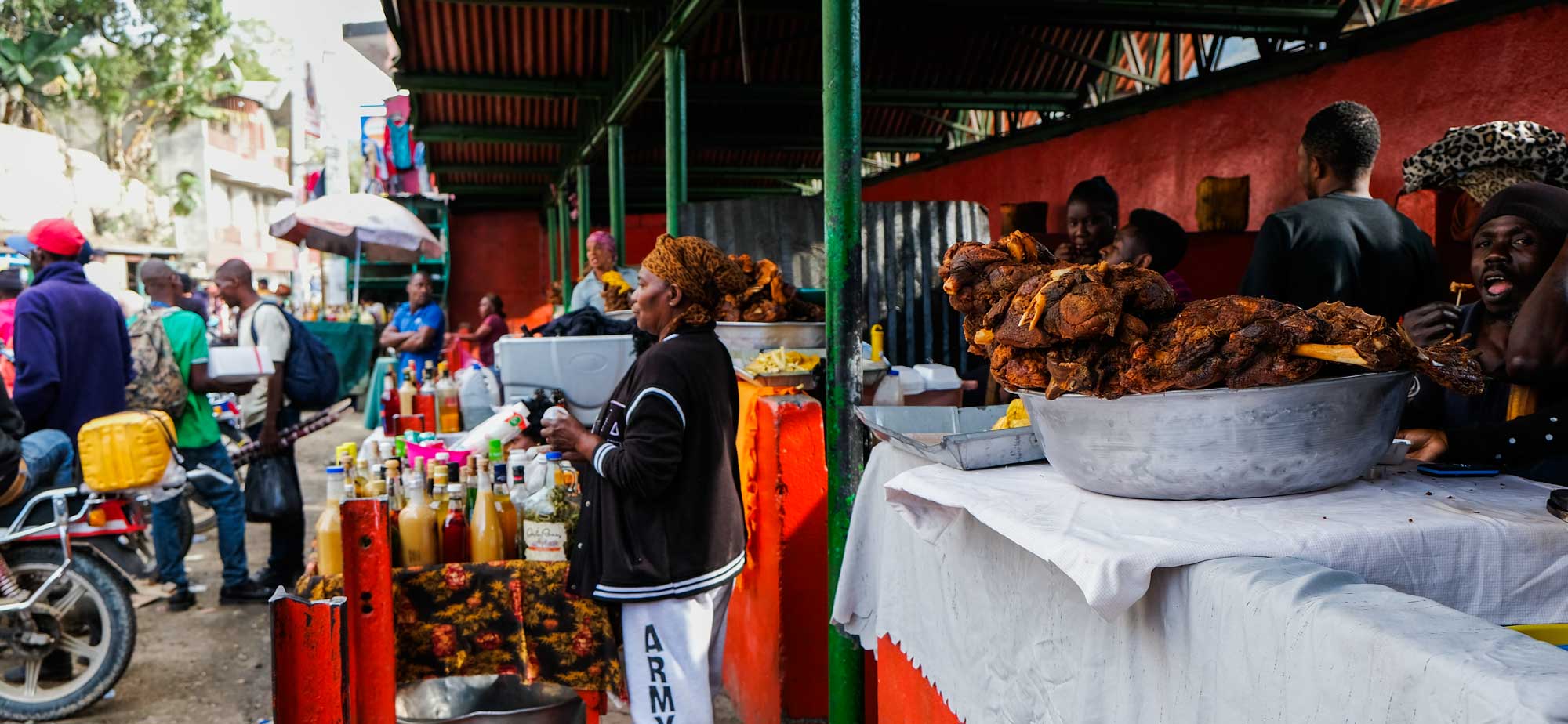
Photo: Franck Fontain
The Haitian Street Food You Have to Try (According to a Local)
This is the Haitian street food you have to try, according to a Jacmel local
Haiti is a land of bold flavours, bright colours, intoxicating music, mischievous gods and a heady mix of cultures. The only thing stronger than the rum, or so they say, is the spirit of the people that live there. So how do Haitians eat?

Photo: Franck Fontain
Island ingredients
Thronging most street corners of Port-au-Prince, you’ll find local marché stall-holders selling fresh produce of all kinds – barrels and baskets piled high with brightly-coloured fresh fruit, unrecognisable vegetables, mushrooms, grains and mountains of raw spices. You’ll also find street food vendors: chatting over bubbling cauldrons of legume stew, flipping fried plantains or folding pastries for a line of locals that stretches around the block.
Street food is serious business in Haiti, and caters mostly to the locals who eat it morning, noon and night. To sample some of the treats on offer or go exploring in search of the essence of Haitian creole cuisine, you’ll need to go in with a bit of advice.
The fast-service restaurant concept hasn’t yet washed ashore in Haiti, so if you want to be able to choose from a row of things you can see and be eating it soon after, street food is where it’s at. It’s also some of the most delicious food you’ll find – simple fare, full of spices and often a surprising mix of ingredients both familiar and strange.
Most of these ingredients – fruit, vegetables, sugar, spices and preserved specialty pikliz – come from the surrounding fields. Nothing here has spent a month on a dark shelf in a supermarket, though some of it may have arrived in Port-au-Prince onboard a ship – delicacies that can’t be grown on the island have to be imported.
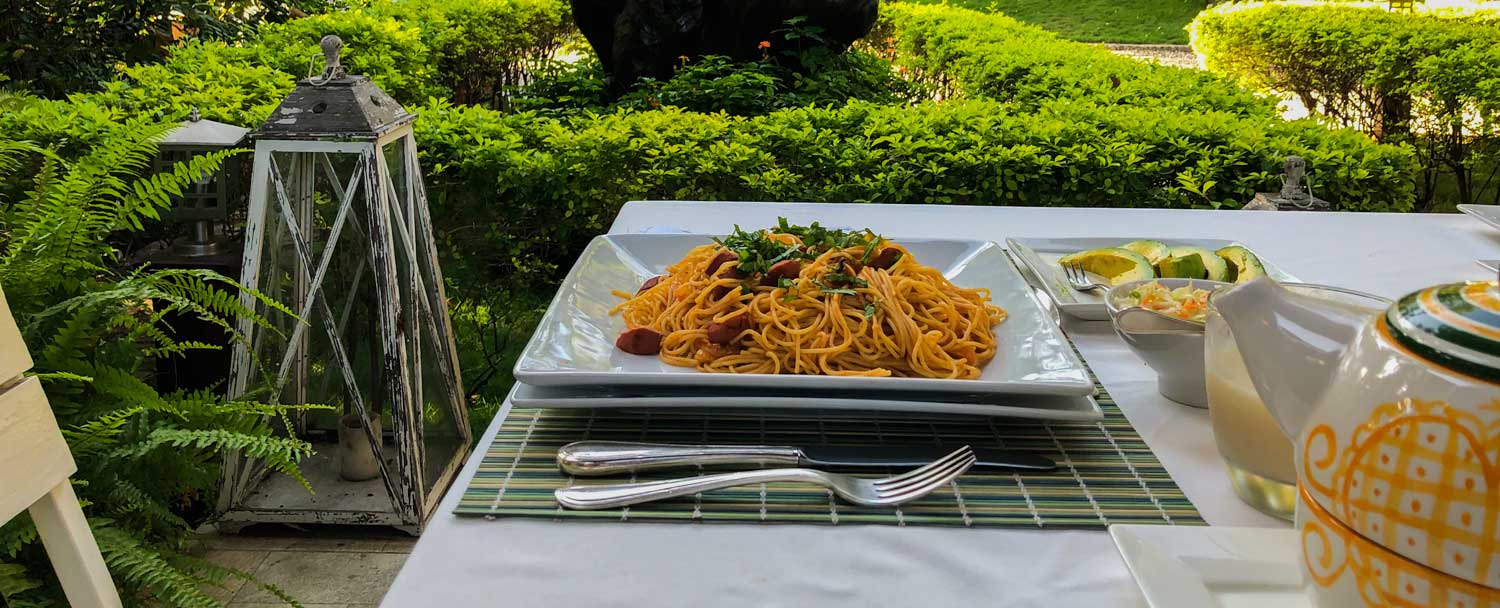
Photo: Anton Lau
01. Breakfast
Hungry? If you’ve woken up in Port-au-Prince you only need to walk a few blocks and you will find a meal worth getting out of bed for.
First up: coffee. In the eighteenth century, Haiti was the proud exporter of half the world’s coffee. That history has left a legacy of coffee-lovers – and some unusual traditions.
For coffee connoisseurs, Haitian roasted and brewed coffee is an eyebrow-raising experience. If you can find a street vendor going through the process of making traditional Haitian coffee out in the open, you’re in for a treat. The beans are roasted with a little sugar and then laid out to dry (think peanut brittle made with coffee beans).
They are then pounded into a fine powder using waist-high large mortar and pestle called a pilon. To brew the coffee they place the powder into a gref, which is a reusable alternative to a coffee filter, sewn from cheese cloth sewn into the shape of a sock (don’t worry – it’s not as bad as it sounds). The coffee grounds are boiled in the gref while heaps of sugar are added, until they have the perfect brew. Delicious! But not necessarily suitable for diabetics.
The paté is the McBreakfast of Haiti. It’s delicious, a complete meal, and packed with calories to get you through a day of adventure. A paté is a deep-fried savory pastry, resembling a pizza pocket with its flavorful stuffing wrapped in dough. Most often, they’re filled with chicken, hot dogs, eggs or a combination of the three.
Another common breakfast is spaghetti – that’s right – but not as you know it. Haitian breakfast spaghetti is served with ketchup, mayonnaise, an egg and a banana. Don’t judge it until you’ve tried it! Maybe you’ve tried all those ingredients before, separately, and you think you know what Haitian spaghetti must taste like. You don’t. Not until you’ve tried it.
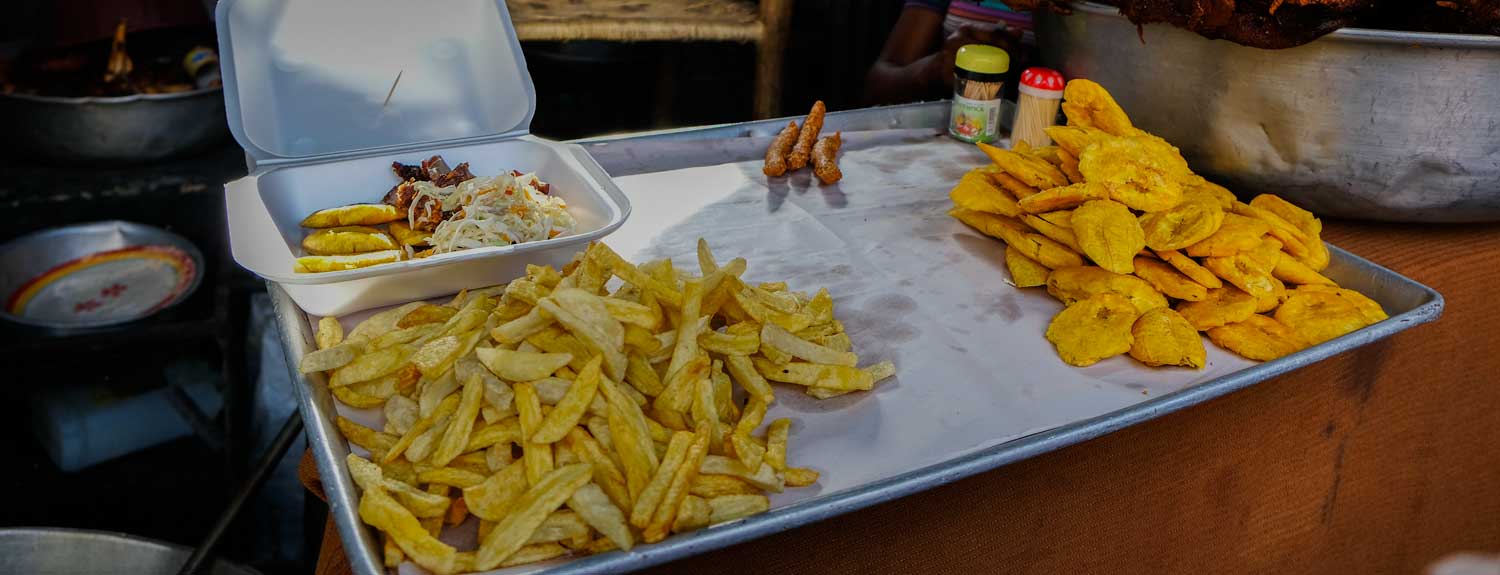
Photo: Anton Lau
02. Lunch
At lunchtime, finding a meal means a little more effort – the streets host fewer machant (vendors) around midday. By now, most breakfast machant have retreated to the shade, but not all of them. Just ask around and you will find someone within a block or two.
Each machant usually makes one or two meals to choose from. The options are usually rice and beans, rice and bean sauce, just rice, cornmeal, cornmeal and bean sauce, or cornmeal mixed with beans. Seeing a pattern here? Many machant also add legum, a stewed vegetable dish, topped with chicken, goat, or beef cooked in a creole sauce.
If you’ve taken a stroll through the meat section of the street markets, you might be wary of eating meat-based street food, but there’s a saying among foreigners living in Haiti that if a foreigner cooks meat then beware, but if a Haitian cooks meat then it’s safe to eat.
The reason? When Haitians cook meat, they first rub it with sour orange, salt and spices. This tenderizes the meat but it also does a good job of cleaning the meat. Then the meat is doused in boiling water, boiled, and fried. The end result: meat that is tasty and safe to eat.
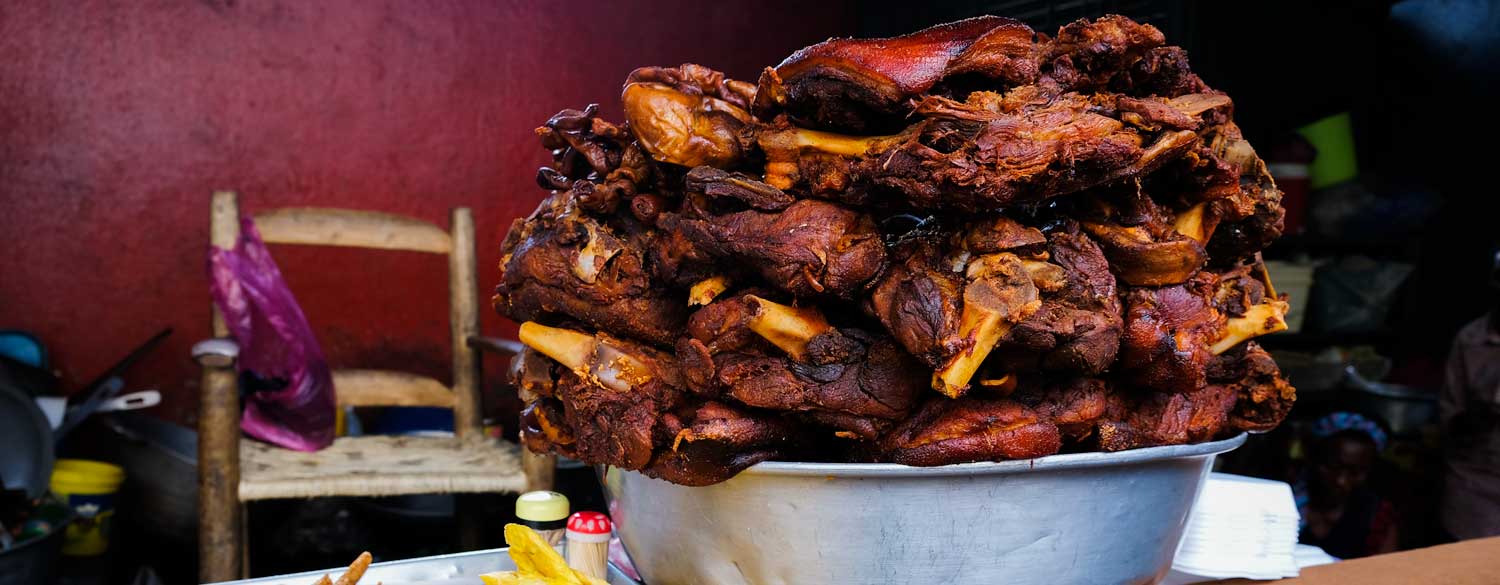
Photo: Franck Fontain
03. Dinner
As the sun begins to fade, fritay emerges on every street corner. Fritay, aka fried food, is where even the most cautious traveler will succumb to temptation. Bannann fri (fried plantain), lam veritab fri (fried breadfruit), and marinad (fried balls of dough mixed with spices) are the standard options available at any fritay vendor’s table. Some will also have chicken, beef, pork or hotdogs. If you’re in luck, you might find sweet potato and even acra, a dough made from cassava root before being…you guessed it! Deep fried.
A helping of fritay is nothing without pikliz. Those that avoid fresh veggies for fear of travellers’ tummy will bend your rules for pikliz. It is to fritay what salsa is to nachos. Made from shredded, spiced and pickled cabbage, onions and carrots, pikliz is the essence of Haitian food.
No two machants make their pikliz alike, and the same holds true for paté, spaghetti, rice and beans, and fritay. Don’t assume that because you eat street food once that you know what Haitian street food tastes like, even down to the local scene that surrounds your hotel. It may take a few tries to find the right machant for you.
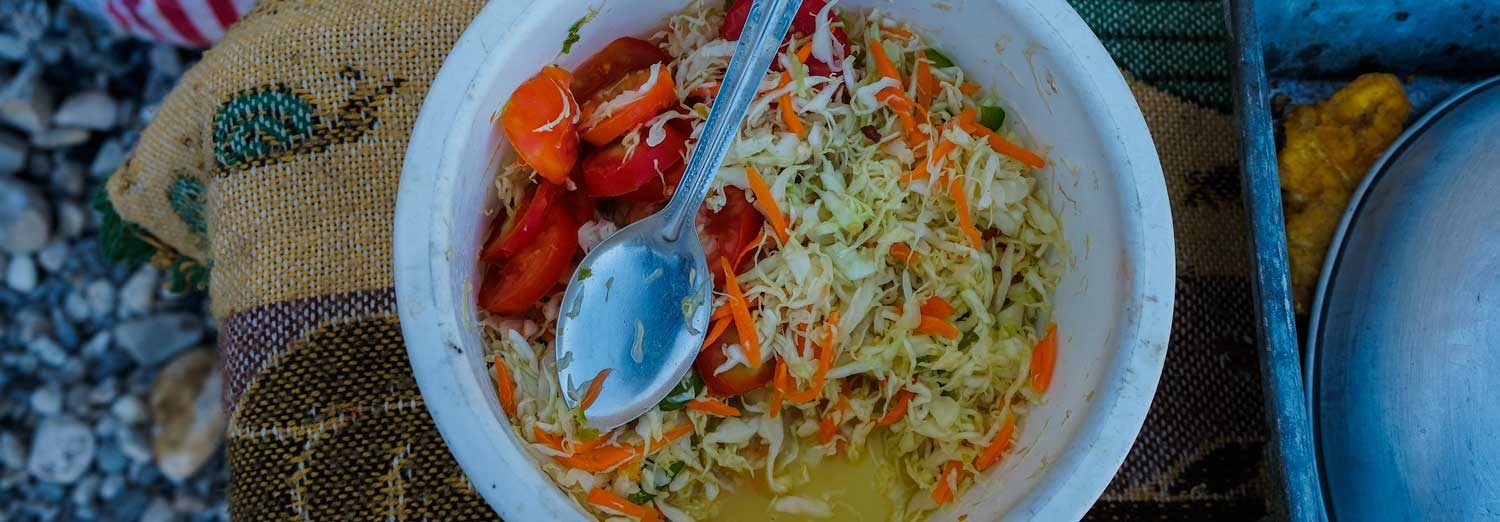
Photo: Franck Fontain
Kleren
Kleren (also spelled Clairin) is the most popular spirit in Haiti. It’s more affordable than rum, and due to its long history of being produced here, there are many suppliers in Haiti – though a few are more well-known than others.
It is what is called a rhum agricole: this means that unlike the majority of rums in the world, it is processed from the juice of sugar cane, instead of the molasses. From this, you get a strong, smooth, unmistakable taste – sharp, powerful, to the point.
Kleren is enjoyed in its pure, unaltered state, but it is quite popular in various flavors, as well. When a root or leaf is added to kleren to soak and infuse, the finished product is called tranpe (literally translating to “dipped” or “soaked”).
You can find Kleren in neighborhood liquor stores and on the menu at some restaurants and street vendors.
Tips to avoid traveller’s tummy
Think you’ve got an iron stomach? An article about street food wouldn’t be accurate if it didn’t mention the risks. Anthony Bourdain one said “Good food, and good eating, is about risk,” but there’s no reason to take more risks than necessary. Here are some pro tips from a local on how to avoid travellers tummy:
-Some machant are better at food safety than others. Ask your local friends, or staff working at your accommodation, which machants they recommend.
-Get it while it’s hot. Avoid pre-cooked food sitting on a tray – instead find a machant who cooks to order. Watch them pull your paté or fritay from the sizzling hot pot of oil and then wait for it to cool a while before you dig in. You’ll have to wait a few minutes longer than if you opt for pre-cooked, but it’s worth the wait.
-Travel with activated charcoal pills and take a couple at the first small twinge in your tummy. That usually does the trick and you will be able to carry on. If you’re really concerned, pack a course of probiotics with you (note: probiotics, not antibiotics) and take them daily to keep your good gut bacteria happy.
-Don’t try street food on your first day in the country. Give your body a few days to adjust to the new environment and the new food before you dig into a plate of spaghetti for breakfast.
Written by Sarah Wallace.
Published November 2018
Top things to see in Haiti

Paradise for your inbox
Your monthly ticket to Haiti awaits! Get first-hand travel tips, the latest news, and inspiring stories delivered straight to your inbox—no spam, just paradise.



